- Home
- :
- All Communities
- :
- Developers
- :
- Python
- :
- Python Questions
- :
- help turning input into user input in arcgis
- Subscribe to RSS Feed
- Mark Topic as New
- Mark Topic as Read
- Float this Topic for Current User
- Bookmark
- Subscribe
- Mute
- Printer Friendly Page
- Mark as New
- Bookmark
- Subscribe
- Mute
- Subscribe to RSS Feed
- Permalink
velocity = float(input("Input asteroid velocity: "))
mass = float(input("Input asteroid mass: "))
ice = float(1.8)
iron = float(7.3)
rock = float(2.3)
comp = input("input 1 for ice, 2 for iron, or 3 for rock: ")
grav = float(0.16667)
const = float(0.007)
colrt = float(1.3)
soil = float(2.65)
power = (int(1)/float(3.4))
vel = (velocity * 1000)
kilotons = (4184000000000)
if comp == 1:
comp = ice
elif comp == 2:
comp = iron
elif comp == 3:
comp = rock
kinetic = (0.5 * mass * (vel * vel))
energy = (kinetic * kilotons)
part1 = (const * colrt * grav)
part2 = (comp / soil)
part3 = (energy * part2)
part4 = (part3 ** power)
crater = (part1 * part4)
final = (crater / int(1000))
print(final)
sorry for the length but i'm trying to take the velocity, mass, and comp and turn them into user input parameters that will be run through the equation and then have it spit out a diameter
my problem is trying to set up the user input part to work with my script. i eventually want to take the script add it to model builder and do more with the output of this script.
any help would be greatly accepted
Solved! Go to Solution.
Accepted Solutions
- Mark as New
- Bookmark
- Subscribe
- Mute
- Subscribe to RSS Feed
- Permalink
It would have been good to read the help since it mentions exactly what you should do, but ok here goes a more compact explanation.
You can create a new toolbox or use an existing one and add a script:
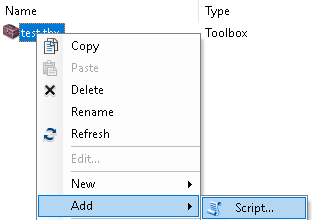
You will have to add the existing Python script (see further down below):

This is what you configure as parameters:
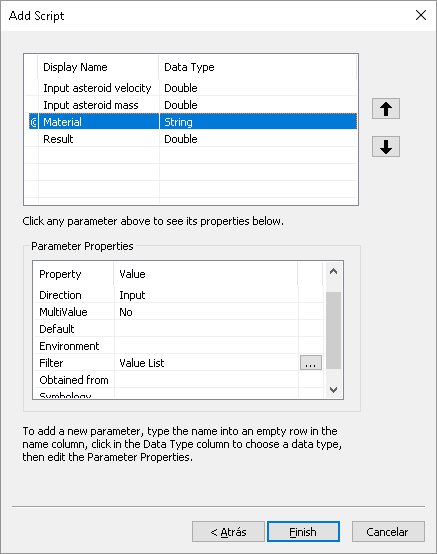
In the lower part the Filter "Value List" will contain the list of materials:
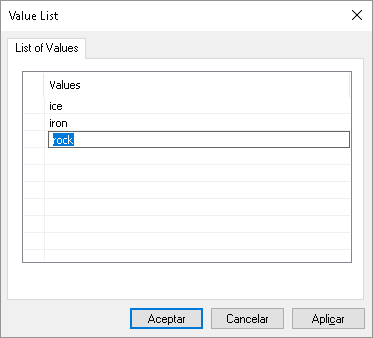
The 4th parameters is the output and should have that "direction":
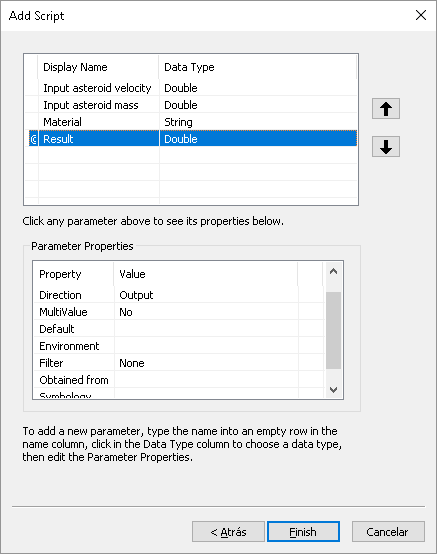
When you execute the tool you can enter all the parameters:
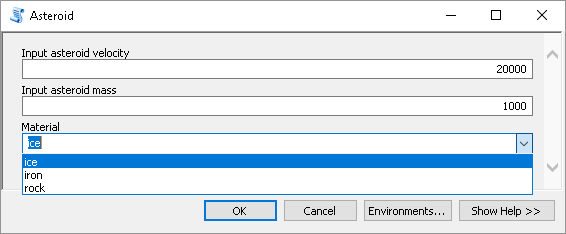
And the result will be:
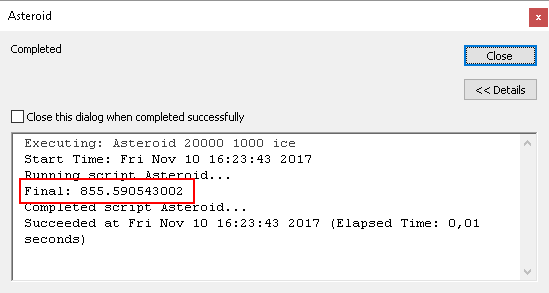
When you load the tool in modelbuilder (simply drag and drop) you will see that you can use it there:
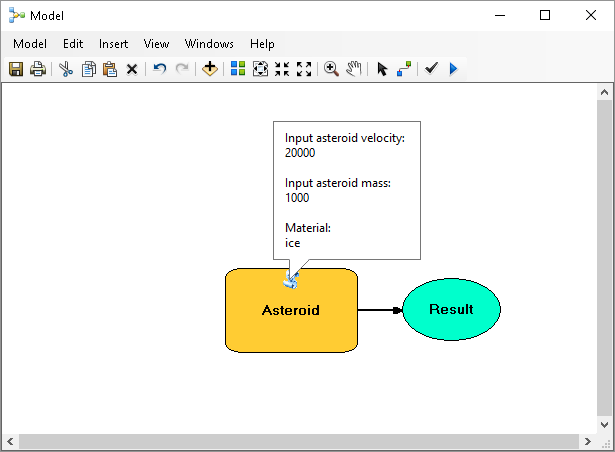
Python script:
def main():
import arcpy
velocity = arcpy.GetParameter(0)
mass = arcpy.GetParameter(1)
component = arcpy.GetParameterAsText(2)
dct_mat = {'ice': 1.8, 'iron': 7.3, 'rock': 2.3}
comp = dct_mat[component]
grav = 0.16667
const = 0.007
colrt = 1.3
soil = 2.65
power = 1.0/3.4
vel = velocity * 1000.0
kilotons = 4184000000000.0
kinetic = (0.5 * mass * vel**2)
energy = (kinetic * kilotons)
part1 = (const * colrt * grav)
part2 = (comp / soil)
part3 = (energy * part2)
part4 = (part3**power)
crater = (part1 * part4)
final = (crater / int(1000))
arcpy.SetParameter(3, final)
arcpy.AddMessage("Final: {}".format(final))
if __name__ == '__main__':
main()
- Mark as New
- Bookmark
- Subscribe
- Mute
- Subscribe to RSS Feed
- Permalink
Please read the following page: Setting script tool parameters—Help | ArcGIS for Desktop
It will show you how to create a script tool with parameters that can be used in ModelBuilder
- Mark as New
- Bookmark
- Subscribe
- Mute
- Subscribe to RSS Feed
- Permalink
i can set up the parameters just fine but i cant seem to get them to run in my script
- Mark as New
- Bookmark
- Subscribe
- Mute
- Subscribe to RSS Feed
- Permalink
have you check to see the type of object that is returned by 'input' in python?
Have your reported the errors that your script returns?
- Mark as New
- Bookmark
- Subscribe
- Mute
- Subscribe to RSS Feed
- Permalink
It would have been good to read the help since it mentions exactly what you should do, but ok here goes a more compact explanation.
You can create a new toolbox or use an existing one and add a script:

You will have to add the existing Python script (see further down below):

This is what you configure as parameters:

In the lower part the Filter "Value List" will contain the list of materials:

The 4th parameters is the output and should have that "direction":

When you execute the tool you can enter all the parameters:

And the result will be:

When you load the tool in modelbuilder (simply drag and drop) you will see that you can use it there:

Python script:
def main():
import arcpy
velocity = arcpy.GetParameter(0)
mass = arcpy.GetParameter(1)
component = arcpy.GetParameterAsText(2)
dct_mat = {'ice': 1.8, 'iron': 7.3, 'rock': 2.3}
comp = dct_mat[component]
grav = 0.16667
const = 0.007
colrt = 1.3
soil = 2.65
power = 1.0/3.4
vel = velocity * 1000.0
kilotons = 4184000000000.0
kinetic = (0.5 * mass * vel**2)
energy = (kinetic * kilotons)
part1 = (const * colrt * grav)
part2 = (comp / soil)
part3 = (energy * part2)
part4 = (part3**power)
crater = (part1 * part4)
final = (crater / int(1000))
arcpy.SetParameter(3, final)
arcpy.AddMessage("Final: {}".format(final))
if __name__ == '__main__':
main()
- Mark as New
- Bookmark
- Subscribe
- Mute
- Subscribe to RSS Feed
- Permalink
... and it would be good to mention the units for mass and velocity in the interface
- Mark as New
- Bookmark
- Subscribe
- Mute
- Subscribe to RSS Feed
- Permalink
Love the folder title xander_bakker.. but where is the map? ![]()
- Mark as New
- Bookmark
- Subscribe
- Mute
- Subscribe to RSS Feed
- Permalink
About the folder title, I thought let´s keep it small...
- Mark as New
- Bookmark
- Subscribe
- Mute
- Subscribe to RSS Feed
- Permalink
this is an extremely big help thank you so much. this is my first time trying to bring python to arcgis.
- Mark as New
- Bookmark
- Subscribe
- Mute
- Subscribe to RSS Feed
- Permalink
Brad... you have some catching up to do... the Py links ....